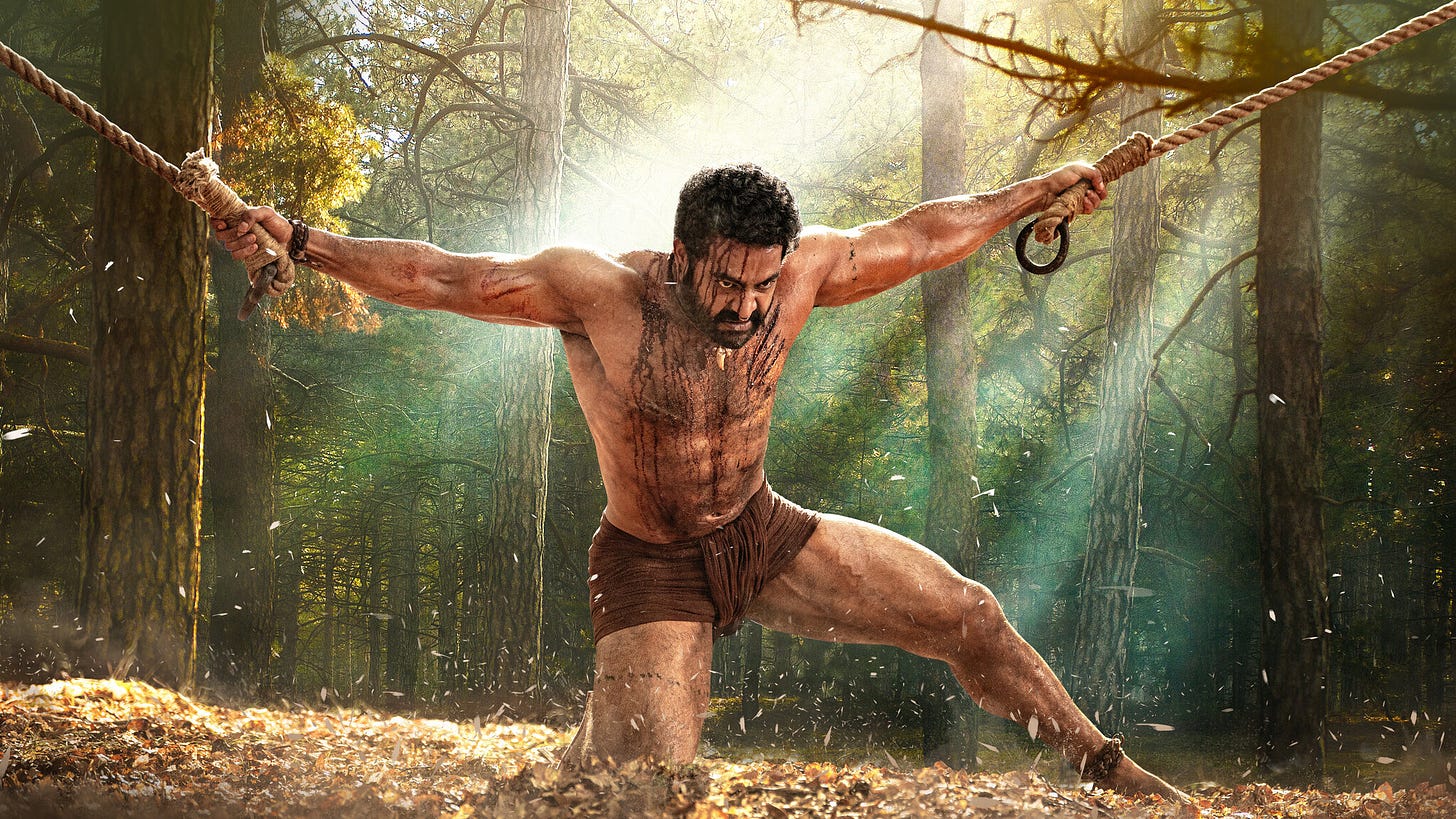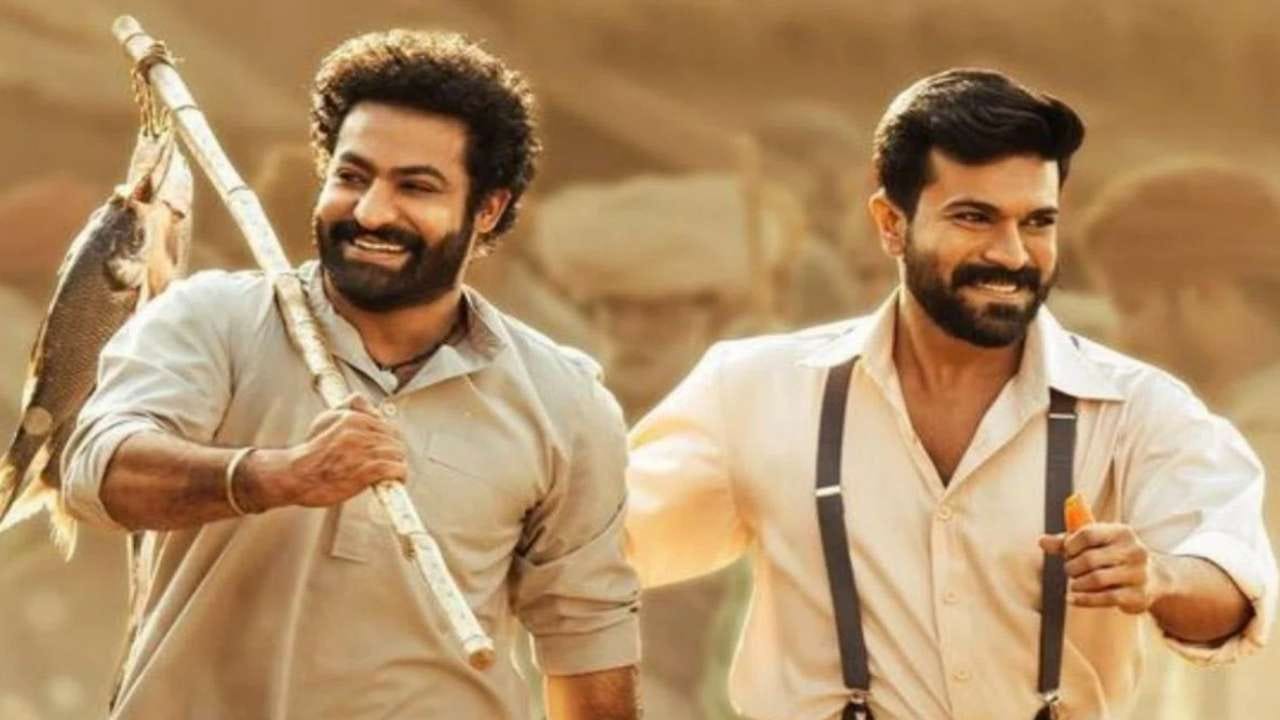Printing the legend: 'RRR' reimagines history as nationalist spectacle
The crossover sensation by director S.S. Rajamouli has the largest budget of any Indian production to date. Not a penny is wasted.
The Telugu sensation RRR opens with two extraordinarily unnecessary disclaimers. The first is that the film’s story, set in pre-independent India, is fictional—along with the characters, the geographical areas, the incidents depicted, the costumes and dances, the linguistic dialects. Etc. (Truly the tl;dr of disclaimers, like the Terms and Conditions of your latest smart phone update.) The second is that no animals were harmed during the making of the film: “The horses, oxen, birds, tigers, wolves, bears, leopards, deer, fish and snake shown in the movie are all computer-generated.” Not a single frame of RRR has yet rolled, yet audiences know they’re about to see a completely outrageous historical fiction featuring a Noah’s Ark of wild animals doing god only knows what. This is not informing viewers of anything they won’t quickly figure out on their own. This is hyping them up.
Now playing on Netflix—albeit in a Hindi-dubbed version that’s somewhat less than ideal—RRR is the most expensive Indian film ever made, and a true international sensation, much like director S.S. Rajamouli’s two Baahubali movies, which also set box office records. In the U.S., where such Indian spectacles remain a niche (though robust) theatrical market, RRR has become the rare breakthrough, crossover event, full of setpieces that people can describe breathlessly to friends or pass around in viral video clips. Where Hollywood blockbusters with nine-figure budgets and ten-cent special effects can make you wonder if the Joker has lit all the money on fire, the $72 million spent on RRR gets as much bang-for-your-buck as El Mariachi. There’s hardly a moment in its 187-minute running time that isn’t visually arresting.
The Reveal is a reader-supported newsletter dedicated to bringing you great essays, reviews and conversation about movies (and a little TV). While both free and paid subscriptions are available, please consider a paid subscription to support our long-term sustainability.
Set in 1920, RRR is the ultimate in “print the legend” historical fiction, mythologizing two real-life Indian revolutionaries, Alluri Sitarama Raju and Komaram Bheem, as super-heroic buddies in the fight against the British Raj, even though in real life the two never crossed paths. For those unfamiliar with Tollywood or Bollywood extravaganzas—and this is the former—imagine a cross between the patriotic kitsch of Mikhail Kalatozov’s I Am Cuba and the high style and action-movie dualities of vintage John Woo, and that gets you some of the way there. The film’s nationalistic fervor feels a little disquieting even if you don’t fully understand all the particulars—the writer Ritesh Babu wrote an epic contextualization of it on his newsletter that’s worth a read—but its power cinema is undeniable.
Joining the pantheon of great movies so busy that the title card doesn’t appear until one or two reels into the action—see also: the Coens’ Raising Arizona and Apichatpong Weerasethahul’s Blissfully Yours—RRR opens in the Adilabad Forest, where vile governor Scott Buxton (Ray Stevenson) and his sadistic wife Catherine (Alison Doody) are so enchanted by the voice and artistic talents of a little girl named Malli (Twinkle Sharma) that they kidnap her from a Gond village. This sends the tribe’s protector, Bheem (N.T. Rama Rao Jr.) on an impossible mission to Delhi to rescue Malli from the heavily fortified palace where she’s being kept. Meanwhile, Ram (Ram Charan) is a police officer who’s introduced beating the crap out of dozens of protestors, but he’s masking a hidden agenda that requires him to earn trust and gain power from British leadership. When word circulates about Bheem’s arrival in Delhi, Ram works relentlessly to bring him to justice, even though they share a common revolutionary cause.
When Bheem and Ram eventually meet and become instant best friends, the essential information they don’t know about each other is rom-com-level absurd. Ram doesn’t realize he’s besties with the man he’s been chasing, and Bheem doesn’t know Ram is the last man in Delhi he should trust. And that’s not even getting to the revelation that their causes are aligned—which, again, is withheld for a mysteriously long time. But the incredible set piece where Bheem and Ram meet typifies the film’s infectious audacity: As a train crashes on a bridge, sending the flaming wreckage tumbling down to the river below, a little boy is trapped in the water. With Ram atop the bridge and Bheem emerging from a crowd gathered by the riverside, the two lock eyes from 100 yards away and seem to formulate a plan wordlessly. The plan? It involves a motorcycle, a horse, a long rope, a flag, and simultaneously leaping from opposite sides of the bridge. The two lock arms when it’s over. Nice to meet you.
The willingness to package multiple tones and genres and play them to the extreme is a big part of Bollywood’s (and Tollywood’s) appeal, which allows RRR to amp up the action and melodrama to cartoonish extremes while making room for spontaneous bursts of musical-comedy. But what makes RRR particularly special is how well Rajamouli seizes on the plasticity of the medium in the digital age: Modern effects have the ability to make the impossible possible, which can also be a serious pitfall because once real-world physics (and pain) go out the window, the action is often drained of gravity and stakes. (Yes, the Marvel Cinematic Universe, your ears are burning.) Rajamouli’s solution is to amplify the ridiculous, which is how the plan to infiltrate the palace grounds involves barreling through the courtyard in a large truck and releasing most of the computer-generated animals mentioned in the opening disclaimer. And if a large stash of celebratory fireworks or TNT happens to get winged in the middle of the chaos, all the better.
The politics of RRR are harder for a Westerner like myself to unpack—again, that Ritesh Babu post is an excellent resource—but it’s not hard to recognize the propagandistic simplicity of a story where Good and Evil are as starkly defined as they are here. Bheem and Ram have a manufactured conflict that could be resolved by a simple conversation, but there’s otherwise so little difference between them that they can precisely synchronize their movements before either says a word to each other. The Brits, by contrast, are extravagantly vicious monsters: the governor makes elaborate arguments against the expense of wasting a single bullet on “brown rubbish,” and his wife produces a thorned whip when a public flogging isn’t as bloody as she’d like. But no decent person should cry over a crude depiction of colonialists, especially in an epic entertainment that’s crafted as a national origin story. Put it on wheels and this film is a parade float.
And yet, it absolutely must be seen to be believed. Moreover, it must be seen to get a glimpse of where movies are going—or, more specifically, where they can go when they can go anywhere. (I’m reminded of what Terrence Rafferty wrote about I Am Cuba in The New Yorker: “They’re going to be carrying ravished film students out of the theaters on stretchers.”) Form and content merge beautifully in RRR: Problematic as it might be, Rajamouli’s flattening of history to mythological extremes goes hand-in-glove with a style that itself departs with reality, or even the “hyper-reality” we get in more subtly augmented CGI action movies. It’s cardboard history written in lightning.






I've watched the early tiger sequence four times now. Pure nonsensical mythic imaginative joy, more over the top than even Justin Lin or Peter Jackson would dare, executed with Spielbergian wit and clarity. Just marvelous.
I'm reading "The Far Pavilions" now and plan to read "Passage to India" next. I try to bundle my historical fiction/non-fiction binges - books on say, colonial India in this instance -- in an attempt to immerse and stay in the same headspace. Its great when movies are available as supplement. Altogether the varying perspectives among the books, movies and other media help (i think) get me closer to what might be the "truth" of what it was like in the region or time. So this movie is now at the top of the queue for me. Though, I suppose the versimilitude may suffer a bit from exaggeration? The books I'm reading, while sympathetic and somewhat sensitive to the Indian culture and history, were written by westerners of a certain age with all the prejudices and misconceptions that entails. I may re-watch Ghandi. But I'm wondering if there are any movies taking place in or about colonial or pre-colonial India that be good supplements to a viewing of RRR?